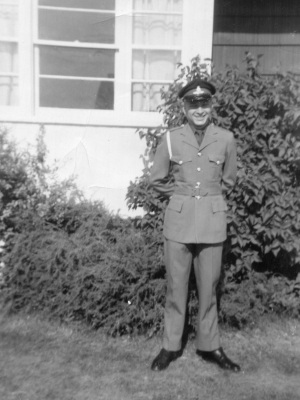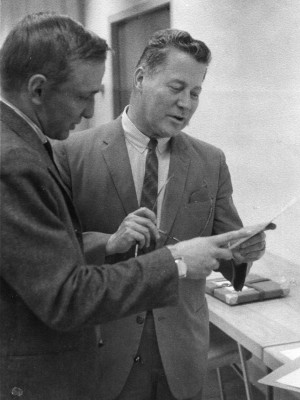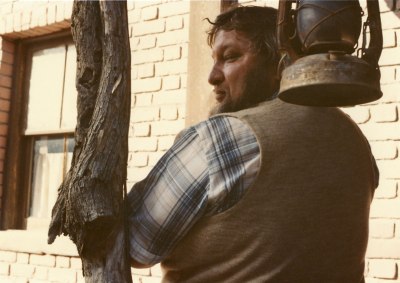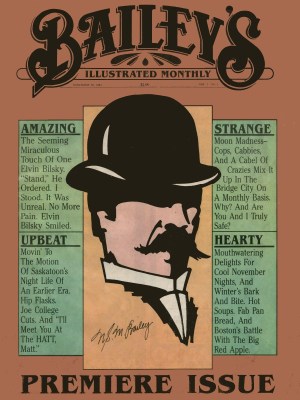I’ve assembled this not-terribly-accurate bio from my own faulty memory of dad’s adventures as he described them to me over the years. I welcome corrections and additions from his family and friends. Please leave your stories and suggested revisions in the comments section. – Michael.
Roger Warner was born in 1946 in Edmonton and died in 2013 in Calgary. In the intervening 67 years he lived and worked in every major town (and most of the minor ones) between Toronto and Vancouver.
Roger grew up in Red Deer, the eldest of eight children. He attended Lindsay Thurber Composite High School, missing his grade 10 year in order to serve as a driver in the Canadian Militia. From this service he acquired the valuable skills of shoe-polishing and shirt-ironing which he occasionally exerted to earn a little extra pocket money from his lazier and slovenlier fellow privates.
His movements over the next few years are hard to keep in order. Leaving home permanently in his mid-teens, he hitchhiked more than once from Alberta to Toronto, where he held a variety of menial jobs. Slinging frozen carcasses in a meatpacking facility he was humbled by the way his much older co-workers, most of them five-foot-tall immigrants from Italy and Portugal, outlifted and outworked him. Employed as an orderly in a hospital he became so inured to his unpleasant duties that he once had a leisurely chat with a co-worker and realized afterward he’d been leaning the whole time on the forehead of a dead patient.
As a teenager Roger had co-hosted, with a fellow student, a show about high school life on Red Deer’s CKRD Radio. This led to a series of writing, announcing, and DJ jobs with stations in Lethbridge, Lloydminster, Regina, Winnipeg, and elsewhere. In the late 1960s he worked in the news department at CHCH-TV in Hamilton, where he interviewed many famous Canadian newsmakers of the era. He told me once that he’d met every Canadian Prime Minister from Diefenbaker through Chrétien (with the exception of Kim Campbell), though the details of most of those encounters are unfortunately lost.
He married my mother, Carole, in Toronto in 1966. At the end of the 1960s they moved to northern Manitoba, where she worked as a teacher in various fly-in native communities while he once again held a number of odd jobs. At one point he was employed in a mine to monitor the level of ore accumulating in a hopper, pushing a button to empty it when it reached a certain level. He soon realized the hopper could be monitored by sound alone, and he spent his time on the job reading. For a while he worked for a logging company, deep in the Manitoba bush, with one grizzled northern lifer for company. On a snowbound night in April 1970 he and his co-worker listened to the live broadcast of the Apollo 13 mission on a fuzzy AM signal that had bounced off the upper atmosphere from a radio station in New Orleans.
In the 1970s , Roger was employed by the federal and Manitoba provincial governments in a variety of roles related to aboriginal and northern economic development. He visited every community, however small, in northern Manitoba, spending countless hours driving from town to town and further countless hours flying from village to village by floatplane. As the ’70s ended he became a freelance writer, pitching many lucrative projects to his former colleagues at the Department of Indian and Northern Affairs. It was around this time that he received his “honourary doctorate”, as he called it, from John Diefenbaker – actually a misunderstanding caused by the ex-PM mishearing his first name as “Doctor”, an error Roger was too shy to correct.
Through the 1980s the contracts flowed in easily and Roger found himself enjoying vaguely-defined but well-paid working trips around the continent. The summer I was seven years old we travelled by car from Saskatoon to Prince Rupert and back, then from Saskatoon to New York City and back, the entirety of this 10,000-kilometre road trip being paid for by the federal government for reasons now obscure. A conference of American Indian chiefs in Las Vegas gave him an excuse to finally visit the American Southwest, a landscape he’d always loved thanks to his interest in western movies. He spent weeks aimlessly driving around the desert with his photographer friend Ray Statham in tow, stopped in Vegas for a day so Ray could snap some photos of the conference, and billed the whole trip to the government.
With the help of Ray and other Saskatoon friends, in 1987 Roger launched an ambitious general-interest newspaper, Bailey’s Illustrated Monthly, with himself as editor and (under a variety of names) primary contributor. The paper, which was delivered free to every household in Saskatoon, claimed a bowler-hat-wearing dilettante named N.S.M. Bailey as its (fictional) publisher and boasted that its pages would contain “no bad news and no political jabberwocky”. Unfortunately this sense of whimsy extended to the publication’s finances, and Bailey’s failed after a few months.
Roger had split with my mother in the early 1980s, and by the end of the decade he was drinking heavily and weighed over 500 pounds. The ambitious and idiosyncratic house he erected in Craven, Saskatchewan, built by an unlicensed contractor based on plans sketched on the back of cocktail napkins, turned into a leaky money pit. Regretfully he said farewell to his skylit ceilings, his built-in library shelves, and the vast outdoor deck he’d designed (a leafy retreat with 10-foot walls enclosing an area equal in size to the house itself), and returned the property to the bank. Meanwhile an acrimonious lawsuit over an unpaid contract put an end to his friendly relationship with the federal government. The Grant Devine Conservative government of Saskatchewan, for whom he’d worked off and on as a communications consultant, lost power in 1991. Work dried up. He had a heart attack and spent weeks in a hospital in Regina.
Out of the hospital, weakened but no longer drinking, Roger gave away most of his possessions, packed his computer and a suitcase in the backseat of his car, and drove to North Vancouver. Through the 1990s he made a precarious living as a freelance writer and marketer, supplementing his income with a few gigs as an extra on Vancouver-filmed TV productions. He landed a steady job as Director of Community Relations for Fairview College, in northern Alberta, in 1998. He would remain in Fairview till the end of his working life in 2011, by far his longest stint in one town and at one job.
After retiring he toyed with the idea of writing a thinly-fictionalized version of his memoirs, but he got no further than an outline. He went into the hospital on New Year’s Day, 2013, and died three weeks later on his 67th birthday.










What a guy. What a life he lived.So sad that he died so young.I remember once and I think it was just before he married my sister that we both went to a hockey game at Maple Leaf Gardens between the Russian National Team and the Ontario Junior All Stars. I Can’t remember just who won but I do remember that the best player on the ice was Bobby Orr who would shortly join the Bosten Bruins. After the game Roger and I headed off to a bar for a few drinks. Half way through the first beer we both looked around, looked at each other, finished our drinks and left. We were in a gay bar.We had a good laugh after that. A fun guy that will greatly be missed.
I just came across this great blog about Roger. I lived with Roger in the backroom of his Craven house for about 6 months in 1987 following my divorce. I was a weekly columnist for the Leader Post and the Star Phoenix at the time. Roger was very heavy at the time and had difficulty walking for any distance. We played many games of chess, which he mostly won, for long hours during the day and into the night. He did drink at bit much and almost every night he would fall asleep with the TV at full blast, which I frequently shut off at late hours. He was an avid reader and he even wrote a movie script for a children story that was popular at the time. I was with him when he worked on Bailey’s. He was lots of fun to be with. He often talked of his adventure with Michael when he took you to New York City to visit Spider Man. I admired Roger a lot.
I’m not sure exactly what triggered it, but no matter the reason I spontaneously Googled the name “Roger Warner” today, and that’s how I learned of his untimely passing.
It was the early ‘70s, and I was just a kid — maybe 16 or 17 — when I met Roger at radio station CHTM in Thompson, MB. He was the news director and I was the high school reporter, record librarian and wannabe DJ — complete with make-believe Walter Cronkite voice. Those were the days when Bonnie Swain (grandmother of CBC’s Dianna Swain) was manager, and William ‘Wild Bill’ Flamond begun his nightly country show with his version of Mule Skinner Blues, his signature theme song that eventually took him to Nashville. All are gone to us now, but I can still picture each of them.
Especially vivid is my memory of Roger, a “larger than life” individual with shaggy beard and imposing frame that gave him a hirsute quality. It was his penchant for story telling that I remember best, though. Often accompanied by a glass or two, and with that distinct voice of his, Roger would set into a tale that might be informative but was always guaranteed to be entertaining! Amusement aside, when it came to the news, however, Roger was a serious writer who could spit out good copy along with the best of them.
I was never sure what various positions Roger held. Having read this tribute, however, I can see why. I now know that he worked at a great variety of jobs throughout the country — one of them being his stint at CHTM. In fact, Roger and I ended up in Ottawa in the mid ’70s. He was with Indian Affairs at the time, and at 20, I had landed a posting on the Hill as a staffer to a member of parliament. So it would have been between 1974 and 1977 that Roger and I reconnected. That was the last time I saw or spoke with him.
I often wondered what became of my old friend. Now I know. Thank you, Michael, for this touching tribute.
Stuart Fraser,
Ottawa
Hi, Stuart. I was really pleased to see your comment. I hadn’t noticed that in the list of towns where my dad was employed in the radio biz, I’d neglected to include Thompson, Manitoba.
(I was born in Thompson some years later, in 1976 – but we moved away when I was still a baby, and I’ve never been back.)
I have several hours of audio recordings of my father reminiscing about his life, made about a decade before he died. (The Diefenbaker anecdotes, above, come from those recording sessions.) Your comment inspired me to relisten to the clips from his Thompson years. Here’s how he describes poaching the News Director job at CHTM:
–Michael.
Michael I was in a Communications workshop with Roger and when we did the exercise on handling scrums, he was most determined in getting the response he wanted. I can picture him getting the interview you describe. Thank you for sharing and hope all is going well with you.